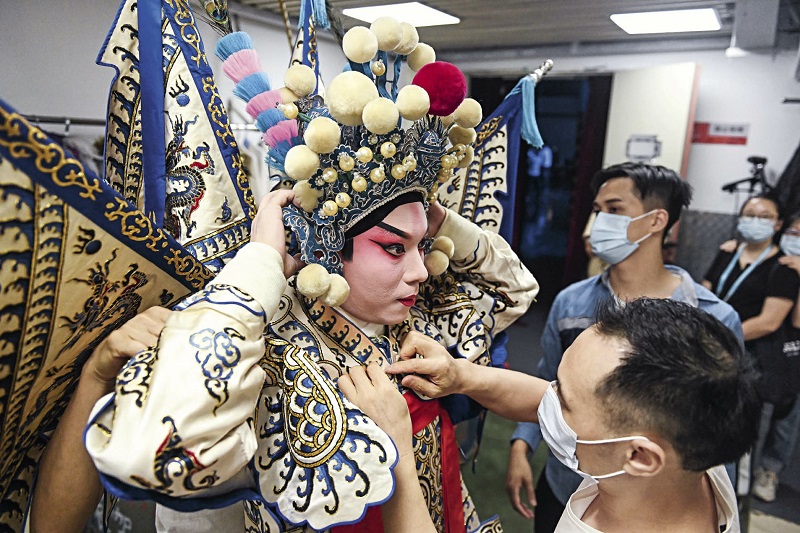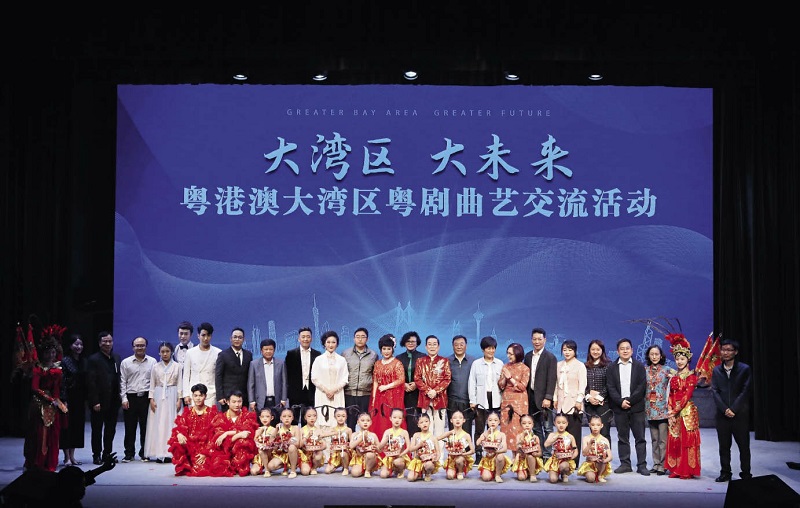Walking along the archaistic streets of Yongqingfang Square in Guangzhou, one will notice a museum built in the architectural style of a Lingnan garden (a typical garden south of the Five Mountain Ridges in south China). That is the Cantonese Opera Art Museum. Standing as a local landmark, the “garden museum” has attracted many Cantonese Opera lovers.
On April 19, the “Greater Bay Area, Greater Future” Guangdong-Hong Kong-Macao Greater Bay Area Cantonese Opera and Folk Arts Exchange, which also served as the launching ceremony of the third Global Micro Cantonese Opera Competition, was held in the museum. Famous Cantonese Opera artists from the three regions of Guangdong, Hong Kong, and Macao participated in this event online and offline.

A Cantonese Opera actor is getting dressed in their costume backstage before a performance at the Guangdong Cantonese Opera Theater on June 12, 2020. That evening, the theater and Kugou Music together stage the classic Cantonese Opera play A Sword of Loyalty for the audience through a live webcast.
The Inheritance Mission
“A bridge flies over the Lingdingyang Bay as it extends from one side to the other side of the Pearl River...” Liang Jinlin sings sonorously at a small theater inside the museum. Liang, now 82-year-old, is a renowned Cantonese Opera performer and a provincial level inheritor of the intangible cultural heritage Cantonese Opera. The play he performs is A Bridge over Lingdingyang Bay, which unfolds to audiences the magnificence of the Hong Kong-Zhuhai-Macao Bridge.
“The cultures of Guangdong, Hong Kong, and Macao have long been integrated and fused with one another. Deeply rooted in this cultural background, Cantonese Opera stands today as the most representative art of the Greater Bay Area. The three regions have been jointly passing down and promoting the Cantonese Opera art for a long time. In 2009, after their joint application to UNESCO, Cantonese Opera was included in UNESCO’s Representative List of the Intangible Cultural Heritage of Humanity,” said Ni Huiying, president of the Guangdong Council for the Promotion of Cantonese Opera.
A famous Cantonese Opera artist, Ni has been engaged in performing the opera for more than 50 years. She said, “Cantonese Opera is a local art form, also an embodiment of the inner cultural connection in the Greater Bay Area. To build a cultural communciation home in a world-class bay area, we must jointly inherit and carry forward this first-class traditional culture. It’s our responsibility and mission.”
In recent years, Ni has been devoted to compiling The Encyclopedia of Cantonese Opera Performing Arts. “Cantonese Opera has a very long history. In the past, it was only taught orally. Now, my colleagues and I want to reorganize its various schools. To do that, we have the daunting task of collecting singing tunes that extend back over nearly 100 years. Until now, around 1,000 people from the three regions have come together and helped us with this endeavor. That has touched us very much,” Ni said.
Liang Yurong is a fourth-generation inheritor of the Xing singing tune school of Cantonese Opera. She is now president of the Guangdong Ballad Singers’ Association. Liang shares with us the innovation made in the Cantonese Opera musical Little Star, in which she stars a major character. “This is a key musical jointly created by artists from Guangdong and Hong Kong. It will be on a 9+2 city tour in the Greater Bay Area. The reason we have chosen the musical as the form of performance this time is to promote Cantonese Opera in a way that will attract more young people to it.”
New Vitality
In 1957, at the sixth World Festival of Youth and Students (WFYS) held in Moscow, Cantonese Opera artist Hong Xiannü won the first gold medal for the local opera with her song Ode to Litchi, in which she sang:
“Inside the red outfit, there’s a jade fruit ball covered by a fine gauze veil. The sweetness lingers in the mouth after a bite. Oh how precious it is!”
Inside the small theater of the Cantonese Opera Art Museum, Guo Fengnü, a national first-grade actress, performed Ode to Litchi again. Her beautiful and melodious voice was well liked by audiences. Chen Yunrong, a student from the Yuexiu School of Guangdong Experimental High School, joined her on the stage. The latter sang a new adaptation of the Cantonese Opera song Eating Litchi in a vibrant childlike style. As a young student, she integrated traditional folk art with popular elements to pay tribute to the classics.
“Cantonese Opera is an art that passes its values and cultural identities down from generation to generation,” said Ou Kaiming, chairman of the Guangzhou Dramatists Association. Ou performs in the Greater Bay Area every year. He also gives lectures on opera art in universities such as South China University of Technology and University of Macau, to spark the interest of more young people in this ancient art.
“People in the Greater Bay Area share the same cultural roots. It is our mission and responsibility to carry forward this Cantonese cultural heritage. We need to use Cantonese Opera as a link to promote communication among youths of the Greater Bay Area and arouse the emotional bond of the younger generation,” said Ou.
Law Kar Ying, a renowned Cantonese Opera performer in Hong Kong, is in the process of shooting the first collaborative film of the Greater Bay Area, Legend of the White Snake, in east China’s Zhejiang Province. In a video interview, he made the following statement about his vision for the development of the Greater Bay Area:
“I hope the Greater Bay Area will bring together Cantonese Opera artists and promote the traditional opera to the outside world. In the future, we look forward to cooperating more closely and more often with people in the Greater Bay Area.”
He has also organized Cantonese Opera training classes for young people in Hong Kong, which include classes for learning to play musical instruments and gongs and drums, in a bid to cultivate successors of Cantonese Opera.

On April 19, the “Greater Bay Area, Greater Future” Guangdong-Hong Kong-Macao Greater Bay Area Cantonese Opera and Folk Arts Exchange, which also serves as the launching ceremony of the third Global Micro Cantonese Opera Competition, is held in the Cantonese Art Museum in Guangzhou City.
A Charming Opera
“With a pure heart and real abilities, to win when I rise, to reflect when I crouch, my warm blood shows my true nature.” These lyrics are taken from the award-winning song Wakening Lion in Lingnan that was performed at the second Global Micro Cantonese Opera Competition.
Lin Weidong, one of its singers, has much to say regarding the opportunities the construction of the Greater Bay Area has brought, “Guangdong, Hong Kong, and Macao share the same cultural roots. Now the Greater Bay Area offers us a platform to spread Cantonese Opera culture and help more young people understand and love this art.”
In recent years, with the construction of the Guangdong-Hong Kong-Macao Greater Bay Area, the traditional cultural treasure of Cantonese Opera has become an increasingly important cultural name card to tell stories in the Greater Bay Area. More and more artists and Cantonese Opera troupes have also joined the league.
“The Global Micro Cantonese Opera Competition is a new form of promoting Cantonese Opera culture in the Greater Bay Area. We encourage innovative creation as well as the inheritance of Cantonese Opera with short and concise micro Cantonese Opera works that reflect the spirit of the area,” remarked one organizer of the competition, “There is a singing competition and a composing competition. With many winners becoming the backbone of Cantonese Opera, we’ve been injecting new blood into the inheritance of this art.”
“Art exchanges are of great importance to the development of the Greater Bay Area. Cantonese Opera has already become a bond that links the three regions,” said Lau Wai Ming, chairman of the Hong Kong Arts Development Council’s opera section and head of the Hong Kong Cantonese Opera Artists Club. “The competition has attracted many lovers of Cantonese Opera. I am moved by their love and enthusiasm for this art,” Lau indicated.
Zhu Zhenhua, executive vice president of the Chinese Drama Artists Association (Macao), said that the Global Micro Cantonese Opera Competition has promoted the development of Cantonese Opera, and new performers mushroom constantly. The platform of the Greater Bay Area facilitates exchanges between Macao and other cities in the area, thus further stimulating the development of Cantonese Opera and adding more color to the traditional culture in the Greater Bay Area.
“Over the years, we’ve been focusing on inheriting and innovating Cantonese Opera and spreading it around the world. Our efforts have borne fruit. Now, we see many overseas Chinese from Tokyo, New York, and the San Francisco Bay Area, even foreign teenagers taking an interest in Cantonese Opera,” said Zhu Xiaoyi, vice director of the Publicity Department of Guangzhou. “Included in our plan to create a world-class bay area that has a matching cultural environment, Cantonese Opera is a valuable gem. I’m confident that as a result of the joint efforts of artists from the Greater Bay Area, this opera form will surely be liked by more and more people in the world,” Zhu indicated.
CHENG LONG and LIN XIAOXI are reporters with People’s Daily.